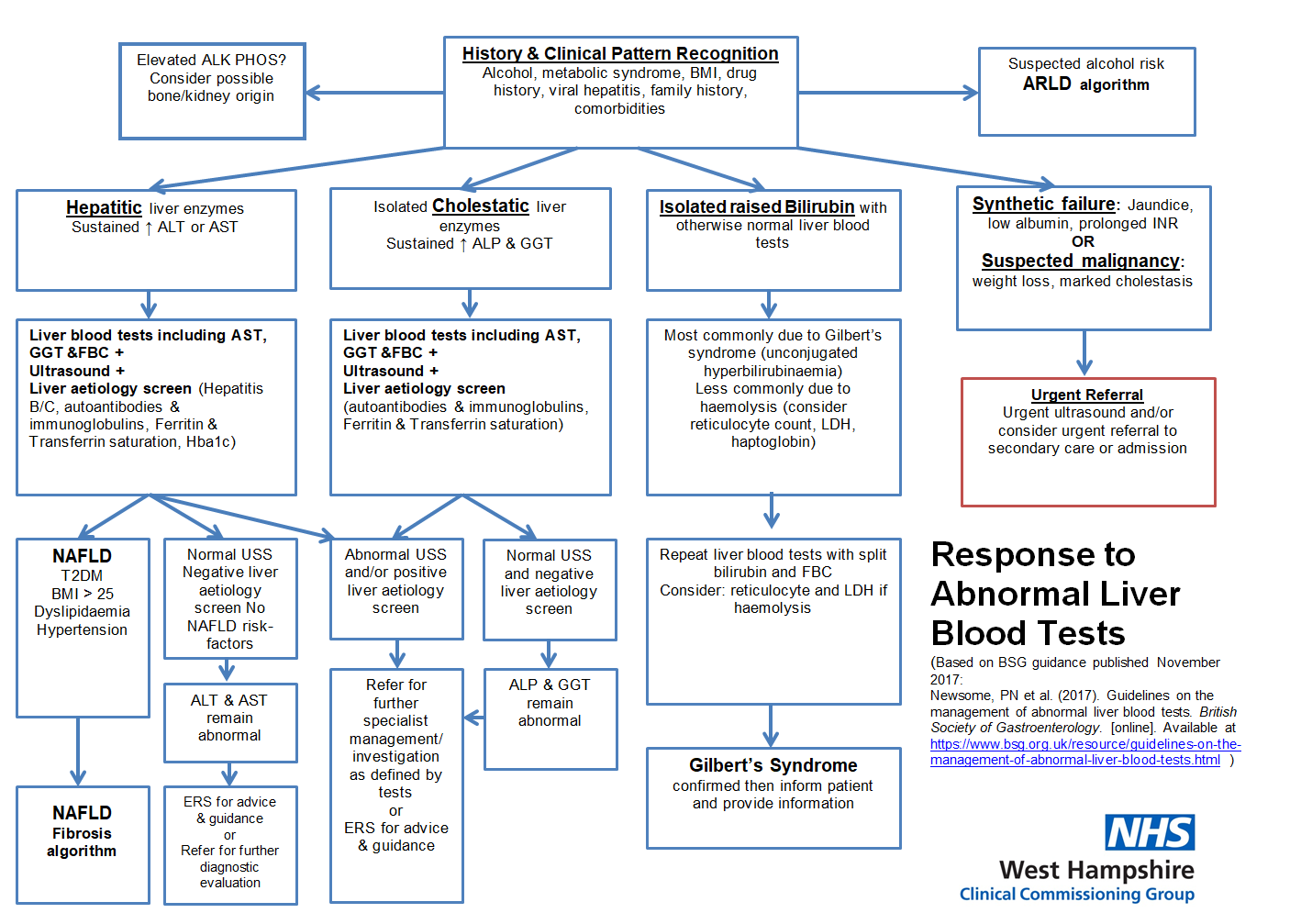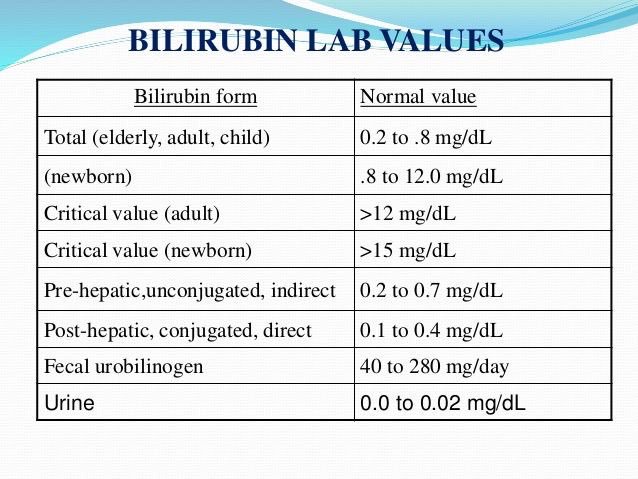Normal values of ast and alt. Normal AST and ALT Values: Understanding Liver Health Markers
What are the normal ranges for AST and ALT liver enzymes. How do high or low levels affect health. What causes abnormal AST and ALT results. What symptoms may indicate liver issues.
Understanding AST and ALT: Key Liver Health Indicators
Aspartate aminotransferase (AST) and alanine aminotransferase (ALT) are crucial enzymes that serve as important markers for liver health. These enzymes are typically found inside liver cells, but when the liver is damaged or inflamed, they can leak into the bloodstream. Monitoring AST and ALT levels through blood tests provides valuable insights into liver function and potential liver disorders.
Are AST and ALT the same thing? While both are liver enzymes, they have distinct characteristics:
- AST is present in various tissues, including the liver, heart, and muscles.
- ALT is more specific to the liver and is considered a more reliable indicator of liver health.
Understanding the normal ranges and implications of AST and ALT levels is essential for assessing liver health and diagnosing potential issues.

Normal Ranges for AST and ALT: What’s Considered Healthy?
The normal ranges for AST and ALT can vary slightly depending on the laboratory and testing methods used. However, generally accepted ranges are:
- AST: 5 to 40 units per liter (U/L)
- ALT: 7 to 56 units per liter (U/L)
Do these ranges apply to everyone? It’s important to note that normal ranges can differ based on factors such as age, gender, and overall health. For instance, men typically have slightly higher normal ranges than women. Additionally, some experts suggest that the upper limit of normal for ALT should be lower, around 30-40 U/L for men and 20-30 U/L for women.
Is a result within the normal range always indicative of good liver health? Not necessarily. Even values within the normal range can sometimes be cause for concern if they show a significant increase from an individual’s baseline levels. This is why regular monitoring and trend analysis are crucial for comprehensive liver health assessment.
High AST and ALT Levels: Causes and Implications
Elevated AST and ALT levels often indicate liver cell damage or inflammation. There are numerous potential causes for high liver enzyme levels:
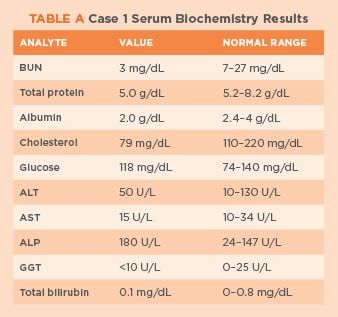
- Alcohol abuse
- Viral hepatitis (A, B, C)
- Nonalcoholic fatty liver disease (NAFLD)
- Medications (e.g., acetaminophen, statins)
- Autoimmune hepatitis
- Liver cancer
- Cirrhosis
Can high AST and ALT levels be temporary? Yes, in some cases, elevated liver enzymes may be transient due to factors such as intense exercise, certain medications, or acute illnesses. However, persistently high levels warrant further investigation.
How high is too high for AST and ALT? While any elevation above the normal range is noteworthy, levels exceeding 10 times the upper limit of normal are considered severe and may indicate significant liver damage. In such cases, immediate medical attention is crucial.
Low AST and ALT Levels: Should You Be Concerned?
While high AST and ALT levels often grab attention, low levels can also be significant. Low liver enzyme levels are less common but may indicate:
- Vitamin B6 deficiency
- Severe liver damage (in advanced stages)
- Certain genetic conditions
Are low AST and ALT levels always a cause for concern? Not necessarily. In many cases, low levels are not clinically significant. However, if accompanied by other symptoms or abnormal test results, they may warrant further investigation.

How low is too low for AST and ALT? There’s no definitive cutoff, but levels consistently below the lower end of the normal range, especially if accompanied by symptoms, should be discussed with a healthcare provider.
AST/ALT Ratio: A Valuable Diagnostic Tool
The ratio of AST to ALT can provide additional insights into liver health and potential underlying conditions. This ratio is particularly useful in distinguishing between different types of liver damage.
What does the AST/ALT ratio tell us?
- AST/ALT ratio less than 1: Typically seen in viral hepatitis and nonalcoholic fatty liver disease
- AST/ALT ratio greater than 2: Often indicative of alcoholic liver disease
- AST/ALT ratio between 1 and 2: May suggest cirrhosis or other advanced liver diseases
Is the AST/ALT ratio always definitive? While the ratio provides valuable insights, it should be interpreted in conjunction with other clinical findings and test results for accurate diagnosis.
Symptoms Associated with Abnormal AST and ALT Levels
Abnormal AST and ALT levels often don’t cause noticeable symptoms, especially in early stages of liver disease. However, as liver damage progresses, various symptoms may emerge:

- Fatigue
- Jaundice (yellowing of skin and eyes)
- Abdominal pain or swelling
- Nausea and loss of appetite
- Dark urine
- Pale stools
- Itchy skin
Can you have liver problems without symptoms? Yes, many liver conditions, especially in their early stages, can be asymptomatic. This is why regular check-ups and liver function tests are important, particularly for those at higher risk of liver disease.
When should you seek medical attention? If you experience persistent symptoms associated with liver problems or have risk factors for liver disease, it’s advisable to consult a healthcare provider for evaluation and possible liver function testing.
Factors Influencing AST and ALT Levels
Several factors can affect AST and ALT levels, potentially leading to temporary elevations or fluctuations:
- Exercise: Intense physical activity can cause temporary elevations in liver enzymes.
- Medications: Certain drugs, including over-the-counter pain relievers, can impact liver enzyme levels.
- Alcohol consumption: Even moderate alcohol intake can affect AST and ALT levels.
- Diet: A high-protein meal before the blood test can slightly elevate enzyme levels.
- Time of day: AST and ALT levels may fluctuate throughout the day.
- Body mass index (BMI): Higher BMI is associated with elevated liver enzymes.
- Gender and age: Normal ranges can vary based on these factors.
How can you ensure accurate AST and ALT test results? To obtain the most accurate results, consider the following:

- Fast for 8-12 hours before the test
- Avoid strenuous exercise for 24 hours prior
- Inform your healthcare provider about all medications and supplements you’re taking
- Limit alcohol consumption before the test
Monitoring and Managing Abnormal AST and ALT Levels
If AST and ALT levels are found to be abnormal, the approach to monitoring and management will depend on the underlying cause and severity of the elevation. Here are some general strategies:
Monitoring
- Regular follow-up tests to track enzyme levels over time
- Additional diagnostic tests (e.g., ultrasound, biopsy) to determine the cause of elevated enzymes
- Monitoring of other liver function markers (e.g., bilirubin, albumin)
Management
- Lifestyle modifications (e.g., reducing alcohol intake, maintaining a healthy weight)
- Treatment of underlying conditions (e.g., antiviral therapy for hepatitis)
- Medication adjustments if drug-induced liver injury is suspected
- Dietary changes and nutritional support
- In severe cases, liver transplantation may be considered
Can abnormal AST and ALT levels be reversed? In many cases, yes. With proper treatment and lifestyle changes, liver enzyme levels can often be brought back to normal ranges. However, the success of reversal depends on the underlying cause and the extent of liver damage.

How long does it take for liver enzymes to normalize? The timeline for normalization can vary widely, from a few weeks to several months, depending on the cause and the individual’s response to treatment. Consistent monitoring and adherence to treatment plans are crucial for successful management.
Prevention: Maintaining Healthy AST and ALT Levels
Maintaining healthy AST and ALT levels is an important aspect of overall liver health. Here are some strategies to help keep your liver enzymes within normal ranges:
- Limit alcohol consumption: Excessive alcohol intake is a leading cause of liver damage.
- Maintain a healthy weight: Obesity is closely linked to nonalcoholic fatty liver disease.
- Exercise regularly: Physical activity helps improve liver function and overall health.
- Eat a balanced diet: Focus on fruits, vegetables, whole grains, and lean proteins.
- Avoid unnecessary medications: Use over-the-counter drugs, especially acetaminophen, as directed.
- Get vaccinated: Hepatitis A and B vaccines can protect against viral liver infections.
- Practice safe sex and avoid sharing needles: These measures help prevent hepatitis B and C transmission.
- Manage chronic conditions: Properly control diseases like diabetes that can impact liver health.
- Stay hydrated: Adequate water intake supports overall liver function.
- Limit exposure to toxins: Be cautious with chemicals and environmental pollutants.
Are there specific foods that support liver health? Yes, certain foods are known to be beneficial for liver function:

- Leafy greens (e.g., spinach, kale)
- Cruciferous vegetables (e.g., broccoli, Brussels sprouts)
- Berries
- Fatty fish rich in omega-3s
- Nuts and seeds
- Green tea
- Coffee (in moderation)
Can supplements help maintain healthy liver enzyme levels? While some supplements claim to support liver health, it’s important to approach them with caution. Always consult with a healthcare provider before starting any supplement regimen, as some supplements can actually cause liver damage if used improperly.
AST and ALT in Special Populations
The interpretation of AST and ALT levels may vary in certain populations or conditions:
Pregnancy
During pregnancy, mild elevations in liver enzymes can occur due to normal physiological changes. However, significant elevations may indicate pregnancy-related liver conditions such as intrahepatic cholestasis of pregnancy (ICP) or HELLP syndrome.
Children
Normal ranges for AST and ALT in children can differ from adult ranges and may vary with age. Interpretation should be done carefully, considering age-specific reference ranges.

Elderly
Liver enzyme levels may naturally decrease with age. However, this doesn’t necessarily indicate improved liver function, and other factors should be considered in assessing liver health in older adults.
Athletes
Intense physical activity can cause temporary elevations in AST and ALT. Athletes may have slightly higher baseline levels, which should be taken into account when interpreting results.
How should AST and ALT be interpreted in these special populations? It’s crucial to consider the context of the individual’s overall health, age, and specific circumstances. Healthcare providers should use age and population-specific reference ranges and consider other clinical factors when interpreting liver enzyme results in these groups.
Are there any specific considerations for monitoring liver enzymes in these populations? Regular monitoring may be more important in certain groups, such as pregnant women at risk for liver complications or elderly patients on multiple medications. The frequency and type of monitoring should be tailored to the individual’s specific needs and risk factors.

Future Directions in Liver Health Assessment
As our understanding of liver function and disease progresses, new approaches to assessing liver health are emerging. These advancements may complement or even replace traditional AST and ALT testing in some cases:
Non-invasive Imaging Techniques
- Fibroscan: Uses elastography to assess liver stiffness and fat content
- Magnetic Resonance Elastography (MRE): Provides detailed images of liver tissue stiffness
Novel Biomarkers
- Cytokeratin-18 fragments: Potential markers for nonalcoholic steatohepatitis (NASH)
- microRNAs: Small RNA molecules that may indicate specific types of liver damage
Genetic Testing
Identifying genetic variants associated with increased risk of liver diseases may allow for earlier intervention and personalized treatment strategies.
Artificial Intelligence
Machine learning algorithms are being developed to analyze complex patterns in liver function tests and other clinical data, potentially improving early detection and diagnosis of liver diseases.

Will these new technologies replace AST and ALT testing? While these emerging technologies show promise, AST and ALT testing is likely to remain a fundamental part of liver health assessment for the foreseeable future. New methods will likely be used in conjunction with traditional tests to provide a more comprehensive evaluation of liver health.
How might these advancements change liver disease management? These new technologies could enable earlier detection of liver diseases, more accurate staging of liver fibrosis, and more personalized treatment approaches. This could lead to improved outcomes and potentially reduce the need for invasive procedures like liver biopsies in some cases.
As research in this field continues to advance, it’s essential for healthcare providers and patients to stay informed about new developments in liver health assessment. Regular check-ups and open communication with healthcare providers remain crucial for maintaining optimal liver health and overall well-being.
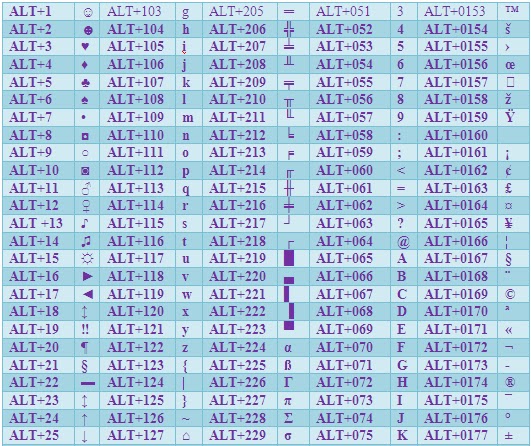
ICP Support – How is ICP diagnosed?
Terminology
April 2022
Why have we changed the term ‘liver function test’ (LFT) to ‘liver blood test’?
Until recently, doctors have tended to call the blood test that looks at how well your liver is working a ‘liver function test’. The test checks to see if there is any inflammation or damage to your liver by looking for abnormalities in liver enzymes, such as:
- alanine aminotransferase (ALT) and/or aspartate aminotransferase (AST) – looks for inflammation
- bilirubin – to see if you’ve become jaundiced (where the whites of your eyes (sclera) can become yellow)
- gamma-glutamyl transferase (GGT) and alkaline phosphatase – can indicate damage/scarring to your liver. NB: in pregnancy, alkaline phosphatase rises without causing any problems to your liver. It can also remain elevated if you are breastfeeding, but this doesn’t mean you have to stop breastfeeding.
However, the phrase ‘liver function’ is misleading because although the enzymes mentioned above may be abnormal (in general liver disease as well as in intrahepatic cholestasis of pregnancy (ICP)), the liver is still doing the job it needs to do – in other words, it still ‘functions’. In ICP the bile flow may be slower than usual (meaning there is cholestasis, indicated by raised bile acid concentrations), but it is still doing everything it needs to do to keep you alive.
In ICP the bile flow may be slower than usual (meaning there is cholestasis, indicated by raised bile acid concentrations), but it is still doing everything it needs to do to keep you alive.
If doctors were worried about liver failure they would perform additional tests to check for this but liver failure is not associated with ICP, which is why you are unlikely to need them.
We think that using the term ‘liver blood test’ is not only more accurate, but will hopefully be less anxiety-provoking, and we anticipate that it will start to be used more frequently over the coming years.
Diagnosis
There is no routine screening for ICP. It is not hard to understand why. One of the challenges is that the condition can present as early as 8 weeks and as late as 40 weeks. This means that women would need repeated screening throughout pregnancy. Also, as it is a relatively uncommon condition of pregnancy (affecting around 5,500 women a year in the UK), the cost implications of testing the whole pregnant population are obvious.
Instead, it is more likely that you will need to mention the itch, either at your antenatal appointment or by phoning the maternity day assessment unit/maternity helpline, and then tests will be performed.
- To make the diagnosis of ICP, other liver conditions and causes of itching may need to be ruled out first. These other conditions may include viral hepatitis, autoimmune hepatitis, and primary biliary cholangitis. It is a good idea to have a liver ultrasound scan in the pregnancy to confirm that nothing else might be causing your symptoms and abnormal blood test results, but the presence of gallstones does not exclude a diagnosis of ICP – it is possible to have both ICP and gallstones. Research shows that women with ICP have a higher chance of either already having had gallstones or of developing them in later life.
- Your doctor will need to ask you about your symptoms and may ask whether anyone else in your family has had liver problems during pregnancy.

- Research and anecdotal (personal reporting) evidence has shown that some women may itch for several weeks before their blood tests show any abnormalities. It is therefore important that you continue to have these tests if your bile acids are normal but you continue to itch.
Blood tests required:
Bile acid test – bile acids are chemicals produced in the liver to help with digestion. In ICP the flow of bile acids in the liver is reduced and they build up in the blood. A bile acid test is the most specific test for ICP and most experts in ICP will not confirm a diagnosis of ICP unless this is raised.
Bile acids have their own circadian rhythm, which means that they naturally rise and fall (within normal reference ranges) over a 24-hour period. The time of day at which you have your blood taken to measure your bile acids can make a small difference to your result, and any increase (within normal reference ranges) doesn’t mean that your bile acids are going to become abnormal or are rising – it could simply be that you have had them tested at a time of day when they are generally a little higher.

The latest research from Mitchell et al. (2021) shows that it is possible to miss the diagnosis of ICP if you fast for your bile acid test. This research also shows that the best time to have your test is around 30–120 minutes after you have eaten. There is no special food to eat – just eat what you would normally have for breakfast or lunch. Given what we have written it may also make sense to be consistent about the time of day you have your test and what you have eaten beforehand. There has been no research about this, but by doing this you will know that your results have not been affected by testing at different times or by eating different food.
(Tap image to enlarge)
(Click image to enlarge)
Not all hospitals perform the test and some hospitals have to send the blood sample elsewhere for testing. Ideally, you should be able to have the results within 48 hours, but we know that this is not possible for all women at the moment. It’s worth asking your health professional to chase your results if you know that they sometimes take longer to come back.
It’s worth asking your health professional to chase your results if you know that they sometimes take longer to come back.
Bile acids are associated with stillbirth in ICP. Because of this risk, most women with ICP have been giving birth to their babies early. Induction has typically been recommended at around 37–38 weeks of pregnancy, but Ovadia et al. (2019) showed that around 90 per cent of women will be able to delay induction until 39 weeks of pregnancy. However, some women with severe ICP (greater than 100 µmol/L) may need to meet their babies from 34–35 weeks of pregnancy onward. It is essential that bile acids are tested frequently in ICP to ensure that women whose levels may rise above 100 µmol/L are identified, and that the results of these tests are received quickly. The majority of bile acids in this research were non-fasting samples, meaning that the level of risk was based on peak bile acid levels – another reason for not fasting for your bile acid test.
Liver blood test (also referred to as a liver function test – LFT) – this blood test looks at how well the liver is working by measuring the levels of different enzymes. The good news is that there is no association between stillbirth and raised liver enzymes in ICP alone. One or more of the following enzymes may be measured in a liver blood test – AST (aspartate aminotransferase), ALT (alanine aminotransferase), alkaline phosphatase or GGT (gamma-glutamyl transpeptidase). The AST and ALT levels are the ones that are used to support the diagnosis of ICP. Research has shown that aminotransferases sometimes rise before the bile acids. In 20% of women who develop ICP, the AST/ALT levels will be normal (Conti-Ramsden et al., 2019). As noted above, experts will not diagnose ICP until the bile acids rise.
(Tap image to enlarge)
(Click image to enlarge)
Reference ranges for blood tests.
 The table below gives the normal values to be expected in both non-pregnant women and pregnant women without ICP.
The table below gives the normal values to be expected in both non-pregnant women and pregnant women without ICP.The values may vary between laboratories – for example, some laboratories cite bile acids as low as <8.3 µmol/L as being abnormal, while others define abnormal as >14 µmol/L. This may be because of the different methods used to test the bile acids (liquid chromatography–mass spectrometry compared to enzymatic testing) or it may be that reference ranges could differ depending on the population involved – the lower range we have quoted seems to be pertinent to the Latina population.
The most recent research (Mitchell et al.) demonstrated that the bile acid threshold for diagnosing ICP should actually be ≥19 µmol/L. This new threshold will take time to filter through to hospitals testing for ICP.
(Tap image to enlarge)
(Click image to enlarge)
Source: Walker I, Chappell LC, Williamson C.
 Abnormal liver function tests in pregnancy. BMJ 2013;347:f6055 (https://doi.org/10.1136/bmj.f6055)
Abnormal liver function tests in pregnancy. BMJ 2013;347:f6055 (https://doi.org/10.1136/bmj.f6055)
(Tap image to enlarge)
(Click image to enlarge)
Next > How is ICP treated?
< Back to About ICP
References
Girling J, Knight CL, Chappell L; on behalf of the Royal College of Obstetricians and Gynaecologists. Intrahepatic cholestasis of pregnancy. BJOG 2022; 1–20. https://doi.org/10.1111/1471-0528.17206.
Conti-Ramsden F, McEwan M, Hill R, Wade J, Abraham G, Buckeldee O, Williamson C, Knight CL, Girling J, Chappell LC. Detection of additional abnormalities or co-morbidities in women with suspected intrahepatic cholestasis of pregnancy. Obstetric Medicine 2019; https://doi.org/10.1177%2F1753495X19868873.
Ovadia C, Seed PT, Sklavounos A, Geenes V, Di Illio C, Chambers J et al. Association of adverse perinatal outcomes of intrahepatic cholestasis of pregnancy with biochemical markers: results of aggregate and individual patient data meta-analyses. The Lancet 2019; http://dx.doi.org/10.1016/S0140-6736(18)31877-4.
The Lancet 2019; http://dx.doi.org/10.1016/S0140-6736(18)31877-4.
Mitchell A, Ovadia C, Syngelaki A, Souretis K, Martineau M, Girling J, Vasavan, T, Fan HM, Seed PT, Chambers J, Walters JRF, Nicolaides K, Williamson C. Re-evaluating diagnostic thresholds for intrahepatic cholestasis of pregnancy: case-control and cohort study. Br J Obstet Gynaecol 2021; 128(10): 1635–1644. https://doi.org/10.1111/1471-0528.16669.
EASL Clinical Practice Guidelines: Management of cholestatic liver diseases. Journal of Hepatology 2009; 51: 237–267. https://doi.org/10.1016/j.jhep.2009.04.009.
Kenyon AP, Nelson Piercy C, Girling J, Williamson C, Tribe RM, Shennan AH. Pruritus may precede abnormal liver function tests in pregnant women with obstetric cholestasis: a longitudinal analysis. BJOG 2001; 108: 1190–2. https://doi.org/10.1111/j.1471-0528.2003.00281.x
Lee RH, Goodwin TM, Greenspoon J, Incerpi M.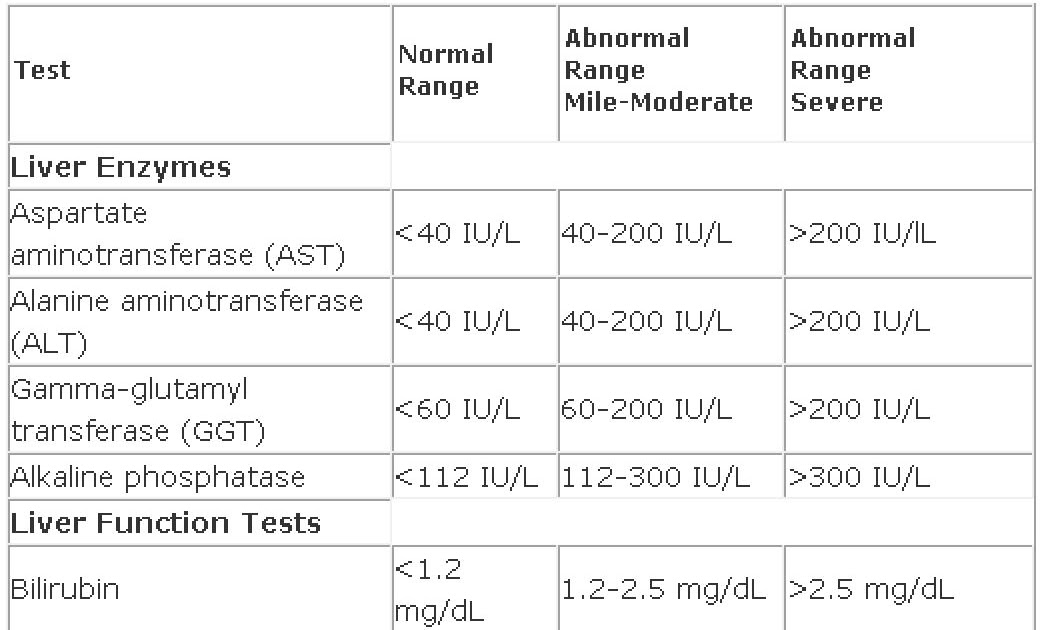 The prevalence of intrahepatic cholestasis of pregnancy in a primarily Latina Los Angeles population. J Perinatol 2006; 26: 527–532. https://doi.org/10.1038/sj.jp.7211545.
The prevalence of intrahepatic cholestasis of pregnancy in a primarily Latina Los Angeles population. J Perinatol 2006; 26: 527–532. https://doi.org/10.1038/sj.jp.7211545.
Marschall HU. Management of intrahepatic cholestasis of pregnancy. Expert Rev Gastroenterol Hepatol 2015; 9(10): 1273–1279. https://doi.org/10.1586/17474124.2015.1083857.
Walker I, Chappell LC, Williamson C. Abnormal liver function tests in pregnancy. BMJ 2013; 347:f6055. https://doi.org/10.1136/bmj.f6055.
Aspartate Aminotransferase (AST) Test – Health Information Library
Test Overview
An aspartate aminotransferase (AST) test measures the amount of this enzyme in the blood. AST is normally found in red blood cells, liver, heart, muscle tissue, pancreas, and kidneys. AST formerly was called serum glutamic oxaloacetic transaminase (SGOT).
Low levels of AST are normally found in the blood. When body tissue or an organ such as the heart or liver is diseased or damaged, additional AST is released into the bloodstream. The amount of AST in the blood is directly related to the extent of the tissue damage. After severe damage, AST levels rise in 6 to 10 hours and remain high for about 4 days.
The AST test may be done at the same time as a test for alanine aminotransferase, or ALT. The ratio of AST to ALT sometimes can help determine whether the liver or another organ has been damaged. Both ALT and AST levels can test for liver damage.
Why It Is Done
This test is done to:
- Check for liver damage.
- Help look for liver disease, such as hepatitis.
 Liver disease may cause symptoms. These may include pain in the upper belly, nausea, vomiting, and sometimes jaundice.
Liver disease may cause symptoms. These may include pain in the upper belly, nausea, vomiting, and sometimes jaundice. - Check to see how well treatment for liver disease is working.
- Find out if jaundice was caused by a blood disorder or liver disease.
- Keep track of the effects of medicines that can damage the liver.
How To Prepare
In general, there’s nothing you have to do before this test, unless your doctor tells you to.
How It Is Done
A health professional uses a needle to take a blood sample, usually from the arm.
How long the test takes
The test will take a few minutes.
Watch
- Learning About Your Blood Test
- Learning About Blood Tests for Children
How It Feels
When a blood sample is taken, you may feel nothing at all from the needle. Or you might feel a quick sting or pinch.
Risks
There is very little chance of having a problem from this test. When a blood sample is taken, a small bruise may form at the site.
Results
Each lab has a different range for what’s normal. Your lab report should show the range that your lab uses for each test. The normal range is just a guide. Your doctor will also look at your results based on your age, health, and other factors. A value that isn’t in the normal range may still be normal for you.
The normal range is just a guide. Your doctor will also look at your results based on your age, health, and other factors. A value that isn’t in the normal range may still be normal for you.
Results are usually available within 12 hours.
High values
High levels of AST may be caused by:
- Liver damage from conditions such as hepatitis or cirrhosis.
- A heart attack or heart failure.
- Many medicines, such as statins, antibiotics, chemotherapy, aspirin, opioids, and barbiturates.
- Very strenuous exercise or severe injury to a muscle.
- High doses of vitamin A.
- Kidney or lung damage.
- Mononucleosis.
- Some types of cancer.

Credits
- Top of the page
Next Section:
Why It Is Done
Health Information Library
Alanine aminotransferase (ALT) | Medical Center “Broad Hearts”
PricesIndications for the appointment of the studyStudying materialWith this study, rent Why do we have
Prices
| Alat | 70 ₽ |
English name: Alanine aminotransferase
Blood test ALT is an enzyme that is found in all cells of the body, mainly in the liver and kidneys. Normally, ALT activity in the blood is very low. In liver problems, the enzyme is released into the bloodstream, usually before characteristic symptoms such as jaundice appear. As such, ALT is often used as an indicator of liver damage.
Together with other studies that perform the same tasks, the analysis for ALT is part of the so-called liver tests.
The liver is a vital organ located in the upper right side of the abdomen. It is involved in many important bodily functions—nutrient processing, bile production, protein synthesis, such as blood clotting factors, and also breaks down potentially toxic compounds into harmless substances.
A number of diseases lead to damage to liver cells, which contributes to an increase in ALT activity.
Most often, an ALT test is prescribed to check if the liver is damaged by hepatitis and taking drugs or other substances that are toxic to this organ. However, ALT does not always reflect only liver damage; the activity of this enzyme can also increase in diseases of other organs.
AST and ALT are considered the two most important indicators of liver injury, although ALT is more specific than AST. In some cases, AST is directly compared with ALT and their ratio (AST / ALT) is calculated. It can be used to identify the causes of liver damage.
It can be used to identify the causes of liver damage.
Indications for testing
- Diagnosis of liver diseases
- Examination of contact persons in the focus of viral hepatitis
- Monitoring of patients with hepatitis of various etiologies
- Donor screening
- Skeletal muscle pathology
- Drug administration control
Test material
Venous blood
Interpretation of test results contains information for the attending physician and is not a diagnosis. The information in this section should not be used for self-diagnosis or self-treatment. An accurate diagnosis is made by the doctor, using both the results of this examination and the necessary information from other sources: history, results of other examinations, etc.
Units: U/l.
Reference values:
Age, gender | Reference values |
0 – 1 year | <56U/L |
1 – 4 years | <29U/L |
4 – 7 years | <29U/L |
7 – 13 years old | <37U/l |
13 – 18 years old | <37d/l |
>18 years male | <41U/l |
>18 years female | <33U/l |
This test is submitted
- Pancreatic amylase
- AST
- Bilirubin total
- Bilirubin direct
- Bilirubin indirect
- Gamma – GT
- Lipase
- Alkaline Phosphotase
Why do we have
At the “Broad Hearts” medical center, you can not only pass all types of tests, but also quickly undergo all the necessary studies to get a complete picture of your health.

Specialists of our center collect and study biomaterial without age restrictions, including from infants.
The use of modern, disposable instruments in a sterile treatment room ensures painless and safe procedures.
It is possible to go home for blood sampling.
For the convenience of patients, the laboratory starts working at 08:00, which allows you to be in time for an appointment with narrow specialists by the time the center opens at 09:00.
Laboratory hours: 08:00 — 21.00.
Addresses of our branches:
Voronezh, st. Vladimir Nevsky, 19, st. Border, 2.
Learn more about laboratory tests from administrators in the MC “Broad hearts”
Pre-recording by tel.: (473) 280-20-30
prices, take tests in Moscow next to you in the Laboratory of
Aspartaminotransferase (AST ) is an intracellular enzyme from the group of aminotransferases, which plays one of the key roles in the exchange of amino acids and providing cells with energy.
AST catalyses the transamination reaction between aspartate and alpha-ketoglutarate.
AST and myocardial infarction
AST is found in the tissues of the heart, liver, kidneys, muscles and other organs. In the myocardium, ACT activity is about 10,000 times higher than in the blood serum of healthy people. Increased ACT activity in myocardial infarction is one of the early markers of cardiac muscle damage, although its specificity is low. The level of ACT in the blood serum increases 6–8 hours after the onset of a pain attack, peaking at 18–24 hours, activity decreases to normal values on days 4–5. With myocardial infarction, ALT activity increases slightly, so the de Ritis ratio – the ratio of AST / ALT – increases sharply.
AST for muscle injury, pancreatitis
ACT values in progressive muscular dystrophy and dermatomyositis reach 8 times the upper limit of the reference values. Pulmonary embolism can lead to a 2- to 3-fold increase in ACT levels.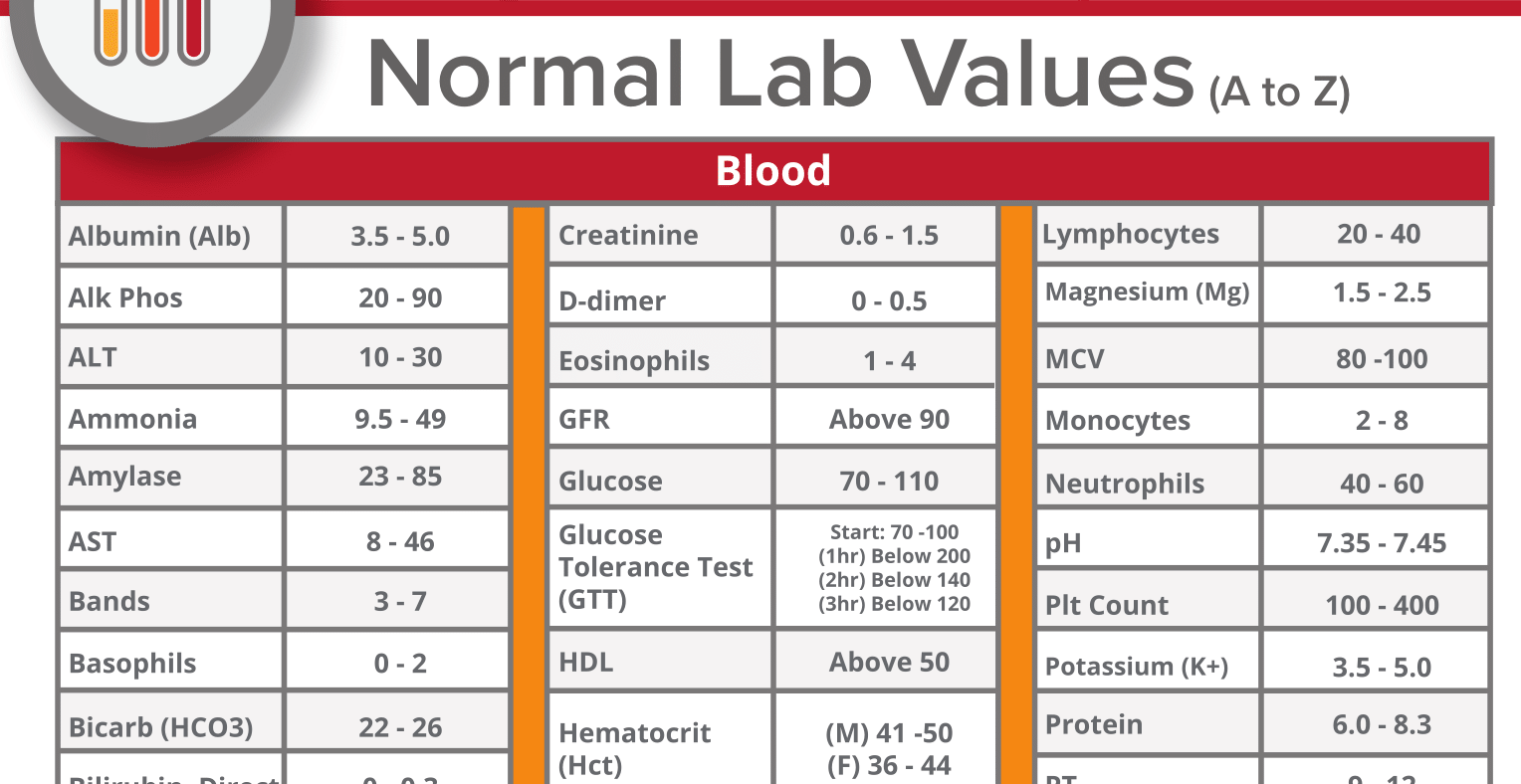
A moderate increase in activity, 2-5 times from the upper limit of the norm, is noted in acute pancreatitis, muscle damage during bruises.
Intense muscular exercise with excessive loading can also cause an incoming increase in serum ACT activity.
There are certain gender differences in the level of ACT activity, the activity of the enzyme in the blood serum in women is slightly lower than in men.
Indications:
- diagnostics of liver diseases;
- examination of contact persons in the focus of viral hepatitis;
- monitoring of patients with hepatitis of various etiologies;
- donor survey.
Preparation
It is recommended to donate blood in the morning, between 8 am and 11 am. Blood is taken on an empty stomach, after 6-8 hours of fasting. Drinking water without gas and sugar is allowed. On the eve of the examination, food overload should be avoided.
Interpretation of results
Units of measure: U/l.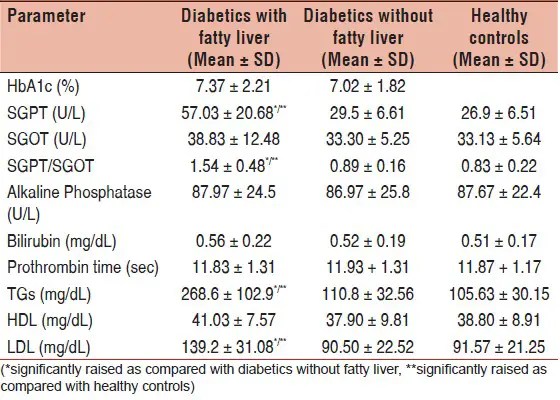

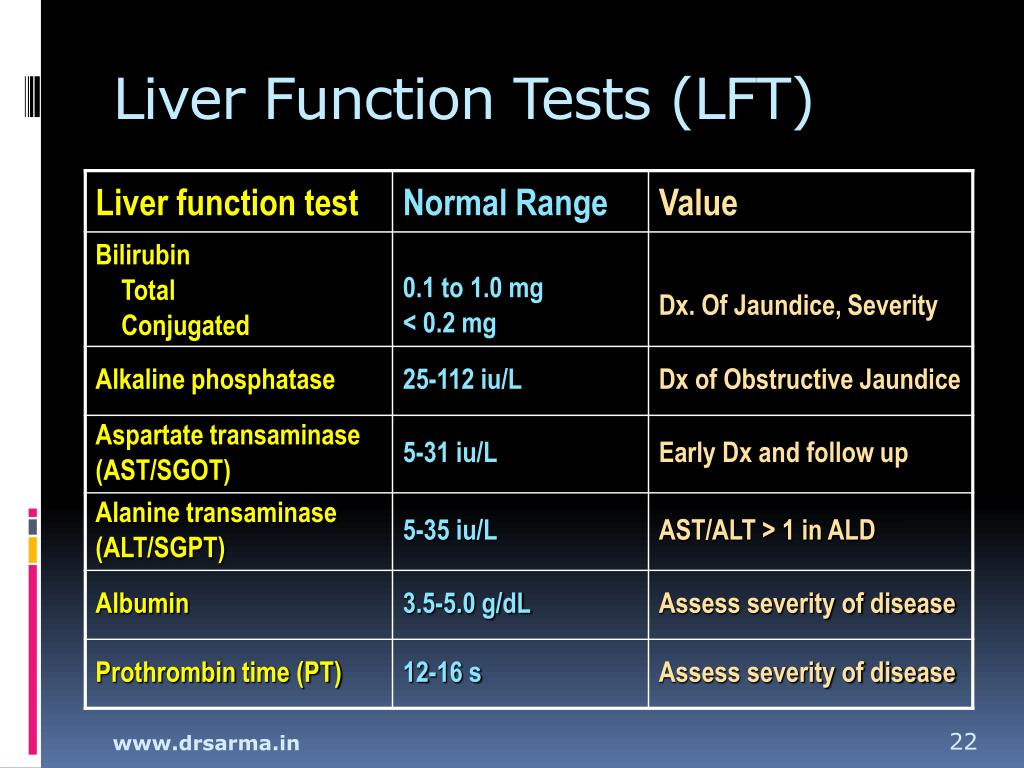

 The table below gives the normal values to be expected in both non-pregnant women and pregnant women without ICP.
The table below gives the normal values to be expected in both non-pregnant women and pregnant women without ICP. Abnormal liver function tests in pregnancy. BMJ 2013;347:f6055 (https://doi.org/10.1136/bmj.f6055)
Abnormal liver function tests in pregnancy. BMJ 2013;347:f6055 (https://doi.org/10.1136/bmj.f6055)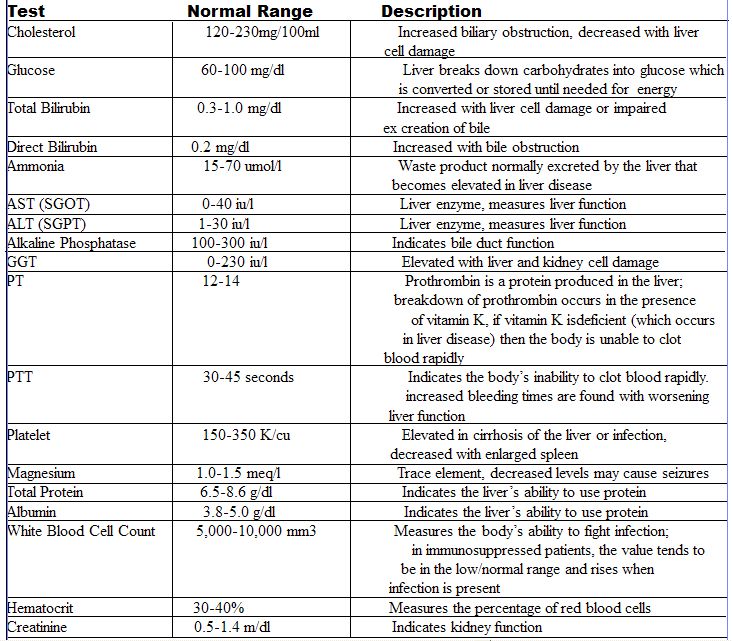 Liver disease may cause symptoms. These may include pain in the upper belly, nausea, vomiting, and sometimes jaundice.
Liver disease may cause symptoms. These may include pain in the upper belly, nausea, vomiting, and sometimes jaundice.